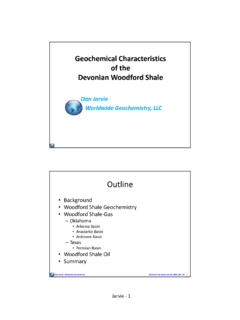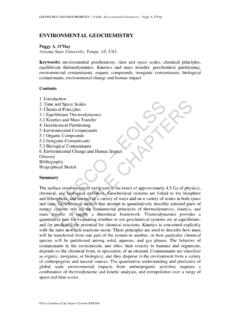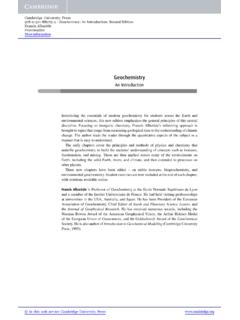Transcription of Organic geochemistry of the AUTHORS Woodford Shale ...
1 Organic geochemistry of theWoodford Shale , southeasternOklahoma: How variablecan shales be?Andrea Miceli Romero and R. Paul PhilpABSTRACTW oodford Shale samples, obtained from a cored outcrop insoutheastern oklahoma , were geochemically analyzed to de-termine vertical variations of Organic facies, thermal maturity,and an evaluation of their depositional environments. Totalorganic carbon values ranged from to , indicatinga good source rock potential. In this area, the Woodford Shaleis marginally mature, as indicated by vitrinite reflectance val-ues. Rock-Eval data revealed that the samples are ,basedonpristane,phytane,steranes, and hopanes, show a mix of marine and terrigenousorganic matter.
2 High-salinity conditions and water densitystratification also prevailed during deposition of this forma-tion, as indicated by the presence of Woodford Shale was subdivided into lower, middle,and upper members based on the integration of geochemicaland geologic data. Moreover, the presence and extent of photiczone anoxia (PZA) were determined by the presence of arylisoprenoids. The lower and upper Woodford Shale memberswere deposited under dysoxic to suboxic conditions and epi-sodic periods of PZA. The middle member was deposited underanoxic conditions and persistent PZA.
3 In addition, aryl iso-prenoids helped infer the position of the chemocline duringdeposition of the different members. The relative hydrocarbonpotential parameter was used in determining transgressive andregressive cycles within the Woodford study undoubtedly demonstrates the significant lith-ologic and chemical variability that occurs within shales. Theapplication of this workflow to regional studies can have aAUTHORSA ndrea Miceli Romero University ofOklahoma, ConocoPhillips School of Geologyand Geophysics, Norman, oklahoma Miceli Romero is a student atthe University of oklahoma .
4 She obtained degree in geochemistry from UniversidadCentral de Venezuela in 2006 and her in geology from the University of Okla-homa in 2010. Her interests include geochem-ical characterization of source rocks and hy-drocarbons from unconventional reservoirs,with emphasis in Paul Philp University of oklahoma ,ConocoPhillips School of Geology and Geo-physics, Norman, oklahoma Paul Philp obtained his degree in chem-istry from the University of Aberdeen in 1968and his and degree from the Uni-versity of Sydney in 1972 and 1998, is currently a geochemistry professor at theUniversity of oklahoma .
5 His interests includegeochemical characterization of unconventionalgas shales, characterization of novel biomarkersand high-molecular-weight hydrocarbons, anduse of stable isotopes in environmental AUTHORS extend their gratitude to the Schoolof Geology and Geophysics at the Universityof oklahoma , Devon Energy, and to the AAPGG rants-In-Aid Foundation for providing the fi-nancial support to this research. We thank RogerM. Slatt, Brian J. Cardott, and Erik P. Kvale fortheir valuable comments and suggestions for thisarticle. Special thanks to Brian J. Cardott for thevitrinite reflectance measurements.
6 Thanks toT. Nichole Buckner for sharing some of her data tosupport some of the results presented here andto the OU-Devon-Schlumberger Project for pro-viding the core samples. The AUTHORS thank thereviewers for their corrections and AAPG Editor thanks the following reviewersfor their work on this paper: Karen S. Glaser,Richard B. Koepnick, and Fang 2012. The American Association of Petroleum Geologists. All rights received January 31, 2011; provisional acceptance April 19, 2011; revised manuscriptreceived July 11, 2011; final acceptance August 10, Bulletin, v. 96, no.
7 3 (March 2012), pp. 493 517493direct influence on exploration and productionactivities in Shale -gas Woodford Shale (Upper Devonian Lower Mis-sissippian), once only considered as a source rock foroil and natural gas in the southern mid-continent,has recently evolved as an important Shale gas playbecause of its high hydrocarbon potential. In south-central and southeastern oklahoma , this formationmainly yields gas and, to a lesser extent, oil (Cardott,2005; Comer, 2007).Considering shales as uniform stratigraphic se-quences in terms of physical and chemical prop-erties is common.
8 However, it has been demon-strated that a more detailed analysis of this sourceand now also reservoir rocks can provide greaterinsights about variations in the depositional andenvironmental factors that influenced its deposi-tion (Hester et al., 1990; Hickey and Henk, 2007;Loucks and Ruppel, 2007; Singh, 2008; Comer,2009; Slatt et al., 2009a, b, c, d).Moreover, industry and academia have workedtogether to evaluate Shale gas characteristics ( , Shale type, Organic content, porosity, permeability,maturity, frac-ability, gas content, reservoir thick-ness, and volumetrics, among others) with the aimof defining sweet spots, gas fairways, or producibleareas of economic potential (Schmoker, 2002; Jarvieet al.)
9 , 2005, 2007; Schenk, 2005; Boyer et al., 2006;Gale et al., 2007; Pollastro, 2007). In this regard, geochemistry is an important factor in Shale gasevaluation. Different approaches and techniqueshave been used to determine maturity and organiccontent of shales: Organic matter type, quantity andprovenance, thermal maturity, type of hydrocar-bons generated, the function of clay minerals inconcentrating Organic matter within the reservoirs,depositional settings, and burial history information has been integrated with infor-mation from other disciplines such as geology,geophysics, reservoir engineering, and petroleumengineering to determine Shale gas potential andattempt todefinepetroleumsystems forthesetypesof plays (Curtis, 2002; Jarvie et al.
10 , 2005, 2007; Hillet al., 2007a, b; Philp, 2007; Pollastro et al., 2007;Zhao et al., 2007; Kinley et al., 2008; Geolog-ical Survey, 2009).The main objective of this study is to geo-chemically characterize the Woodford Shale interms of Organic richness, Organic matter type, hy-drocarbon generation potential and thermal ma-turity, variations in Organic matter sources, anddepositional environments, which are linked to thegeology and sequence stratigraphy of this play insoutheastern GEOLOGYThe Woodford Shale is an Organic -rich black shalecharacterized by the presence of chert, siltstone,sandstone, dolostone, and light-colored Shale .









